
The Type 23 frigate or Duke class is a class of frigates built for the United Kingdom's Royal Navy. The ships are named after British Dukes, thus leading to the class being commonly known as the Duke class. The first Type 23, HMS Norfolk, was commissioned in 1989, and the sixteenth, HMS St Albans was commissioned in June 2002. They form the core of the Royal Navy's destroyer and frigate fleet and serve alongside the Type 45 destroyers. They were designed for anti-submarine warfare, but have been used for a range of uses. Nine Type 23 frigates remain in service with the Royal Navy, with three vessels having been sold to the Chilean Navy, one being retired in 2021, and three more being retired up to 2024.

HMS Edinburgh was a Type 42 destroyer of the Royal Navy. Edinburgh was built by Cammell Laird of Birkenhead. She was launched on 14 April 1983 and commissioned on 17 December 1985. The largest of the Type 42 destroyers, Edinburgh was known as the "Fortress of the Sea". Edinburgh was the last of the Type 42 destroyer to serve in the Royal Navy and was decommissioned on 6 June 2013.

HMS Montrose was the eighth of the sixteen-ship Type 23 or Duke class of frigates, of the Royal Navy, named after the Duke of Montrose. She was laid down in November 1989 by Yarrow Shipbuilders on the Clyde, and was launched on 31 July 1992 by Edith Rifkind, wife of Malcolm Rifkind, Secretary of State for Defence. She was commissioned into service in June 1994.

The third HMS Argyll was a Type 23 Duke-class frigate. Prior to her retirement, she was the oldest serving Type 23 frigate in the Royal Navy. Like all of her class she was named after a British dukedom, in this case that of Argyll. HMS Argyll was laid down in March 1987 by Yarrow Shipbuilders at Glasgow, and launched in 1989 by Lady Wendy Levene, sponsored by the Worshipful Company of Paviors. She was commissioned in May 1991.

HMS Lancaster is a Duke-class Type 23 frigate of the Royal Navy, launched by Queen Elizabeth II on 24 May 1990. The ship is known as "The Queen's Frigate", the Duke of Lancaster being a subsidiary title of the Sovereign. Being the third ship in the Type 23 class, Lancaster was originally allocated the pennant number F232 until it was noted that the 232 is the Royal Navy report form for groundings and collisions and therefore considered unlucky. She is one of the few ships left in the fleet with some female officers but mess decks which are men-only. It is quite common when she has returned from long operations that she is flown over by the Avro Lancaster bomber which is part of the Battle of Britain Memorial Flight based at RAF Coningsby.

HMS Monmouth was the sixth "Duke"-class Type 23 frigate of the Royal Navy. She was the seventh ship to bear the name and was launched by Lady Eaton in 1991, being commissioned two years later.
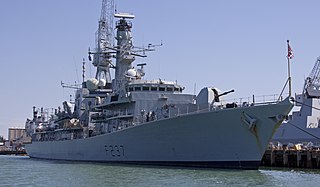
HMS Westminster is a Type 23 frigate of the Royal Navy, and the second ship to bear the name. She was launched on 4 February 1992 and named after the Dukedom of Westminster.

HMS Northumberland is a Type 23 frigate of the Royal Navy. She is named after the Duke of Northumberland. She is the eighth RN ship to bear the name since the first 70-gun ship of the line in 1679, and the ninth in the class of Type 23 frigates. She is based at Devonport and is part of the Devonport Flotilla.
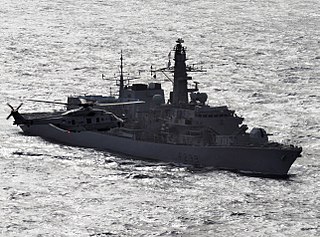
HMS Richmond is a Type 23 frigate of the Royal Navy. She was launched on 6 April 1993 by Lady Hill-Norton, wife of the late Admiral of the Fleet The Lord Hill-Norton, and was the last warship to be built by Swan Hunter Shipbuilders. She sailed from the builders on the River Tyne in November 1994. She is named for the Dukedom of Richmond.

HMS Somerset is a Type 23 frigate of the Royal Navy. She is the eleventh ship of the class to join the fleet since 1989. She was built by Yarrow Shipbuilders Ltd on the River Clyde, in Scotland and was launched in June 1994 by Lady Elspeth Layard, wife of then 2nd Sea Lord Admiral and Commander-in-Chief Naval Home Command Admiral Sir Michael Layard. She entered service in 1996. Lady Layard is the ship's sponsor. She is named after the Dukedom of Somerset.

HMS Sutherland is a Type 23 frigate of the British Royal Navy. She is the thirteenth ship in the Duke class of frigates and is the third ship to bear the name, more than 200 years since the name was last used.
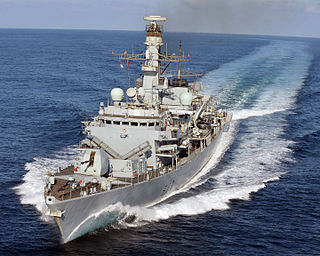
HMS Kent is a Type 23 Duke class frigate of the Royal Navy, and the twelfth ship to bear the name, although formally she is named after the dukedom rather than the county. Sponsored by Princess Alexandra, The Hon. Lady Ogilvy, Kent was launched on 28 May 1998 and commissioned on 8 June 2000 under the command of then Commander John Clink. She was the first ship to enter Royal Navy service in the 21st century and the first Royal Navy warship with a female Executive Officer, Lt Cdr Vanessa Jane Spiller, appointed in April 2001.
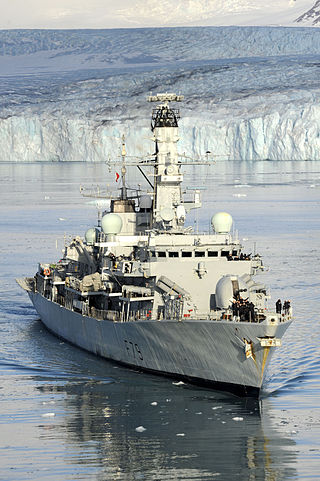
HMS Portland is a Type 23 frigate of the British Royal Navy. She is the eighth ship to bear the name and is the fifteenth and penultimate ship of the 'Duke' class of frigates, and is named for the currently extinct title of the Dukedom of Portland, and more particularly for the third Duke, who was Prime Minister.
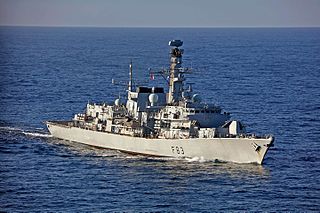
HMS St Albans is a Type 23 frigate of the Royal Navy. She is the sixth ship to bear the name and is the sixteenth and final ship in the Duke-class of frigates. She is based in Devonport, Plymouth.
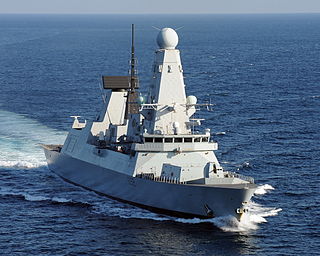
HMS Daring is the lead ship of the Type 45 or Daring-class air-defence destroyers built for the Royal Navy, and the seventh ship to hold that name. She was launched in 2006 on the Clyde and conducted contractor's sea trials during 2007 and 2008. She was handed over to the Royal Navy in December 2008, entered her base port of Portsmouth for the first time in January 2009 and was formally commissioned on 23 July 2009. As the lead ship of the first destroyer class built for the Royal Navy since the Type 42 in the 1970s, she has attracted significant media and public attention. Her name, crest and motto are a reference to the Roman youth Gaius Mucius Scaevola, famed for his bravery.

HMS Dauntless is the second ship of the Type 45 or Daring-class air-defence destroyers built for the British Royal Navy. She was launched at Govan in January 2007, was handed over to the Royal Navy on 3 December 2009 and was formally commissioned on 3 June 2010.

HMS Dragon is the fourth ship of the Type 45 or Daring-class air-defence destroyers built for the Royal Navy. She was launched in November 2008 and commissioned on 20 April 2012.

HMS Defender is the fifth of the Type 45 or Daring-class air-defence destroyers built for the Royal Navy. She is the eighth ship to bear the name. Construction of Defender began in 2006, and she was launched in 2009. The ship completed her first sea trials in October and November 2011, and was commissioned during March 2013.

HMS Duncan is the sixth and last of the Type 45 or Daring-class air-defence destroyers built for the Royal Navy and launched in 2010. Duncan is named after Adam Duncan, 1st Viscount Duncan, who defeated the Dutch fleet at the Battle of Camperdown on 11 October 1797. The destroyer has served in the Mediterranean, Black, and Caribbean Seas, and in 2019 was deployed to the Persian Gulf in response to increased tensions with Iran in the region.

























